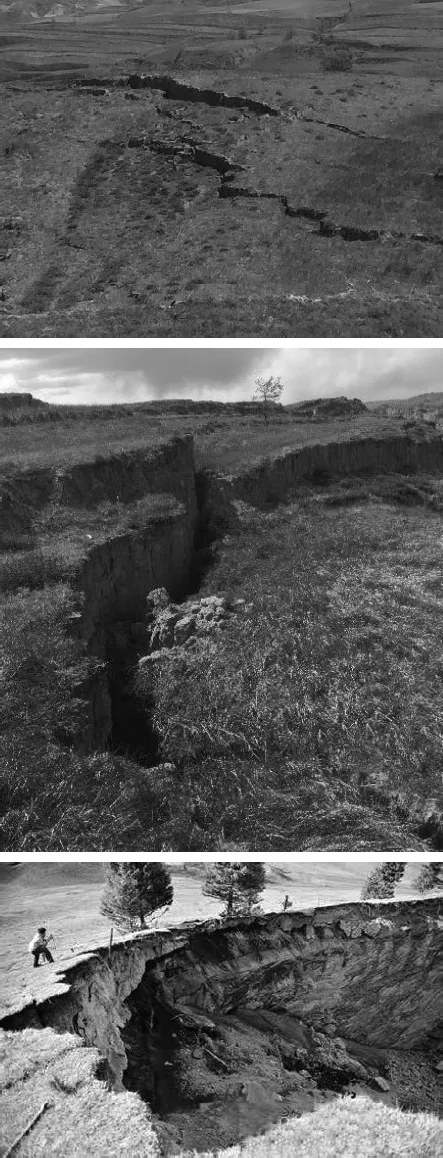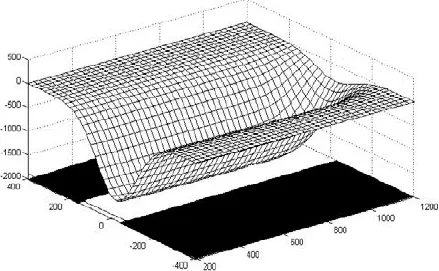![]()
1 General features of surface movement basin
Wenbing Guo and James Barbato
1.1 INTRODUCTION
After coal mining, the immediate roof strata above the gob move and bend downward under the action of dead weight stress and the gravity of overlying strata (Peng 1992; Yuang et al. 2010). When the stress exceeds the strength of the rock layer, the immediate roof breaks, and falls successively. The main roof moves and bends along the normal direction to the bedding plane in the forms of beam or plate, resulting in fracture and separation. As the face advances, the range of strata affected by mining expands continuously. When the mining area is large enough, the strata movement reaches the surface. It forms a subsidence basin on the surface that is much larger than the gob area (Fig. 1.1).
Fig. 1.1. Overburden strata and surface movement due to longwall coal mining.
Surface subsidence caused by underground coal mining is a very complicated process in time and space. The movement of the surface point goes through a whole process from movement initiation to violent movement and finally to a stop. Since the characteristics of surface subsidence after the face has stopped (final subsidence) differ from those when the face is moving (dynamic subsidence), both must be investigated (Guo 2019; Peng 2017).
1.2 FORMATION OF THE SURFACE MOVEMENT BASIN
1.2.1 Types of surface movement
1.2.1.1 Surface movement basin
During underground longwall mining, when the gob reaches a certain size, overburden strata movement reaches the surface and forms a low area of limited size above the gob. This area is much larger than the mined-out area and is known as the surface subsidence basin, or more exactly the surface movement basin (Plate 1). When the coal seam is horizontal and the gob is rectangular in shape, the movement basin is approximately elliptical immediately above the gob. The formation of a surface subsidence basin changes the original form of the surface, causes the elevation and horizontal position of the surface to change, and has an impact on surface structures such as houses, roads, rivers, railways, the ecological environment and so on (Zhang et al. 2003).
1.2.1.2 Cracks, compression heave and steps
In the outer margin area of a surface movement basin, cracks may occur on the surface. The depth and width of cracks are related to the presence and thickness of the surface alluvium layers. Cracks are generated when the plasticity of the alluvium layers is high and the surface tensile deformation exceeds 6–10 mm/m. Generally, the surface cracks are not connected with the underground longwall gob, and may disappear at some depth. When mining intensity is high, cracks or steps may appear on the surface (Fig. 1.2).
Fig. 1.2. Types of surface damage caused by longwall mining.
1.2.1.3 Collapse pit, potholes/sinkholes
Collapse pits often appear in steep coal seams, but occur more easily in special geological and mining conditions. When the mining depth is very small and the mining height is very large, the failure height of overburden is not consistent. This is due to different mining heights resulting in funnel-shaped collapse pits on the surface.
Cracks, steps or sinkholes on the surface can be very harmful to surface structures. Therefore, when mining under buildings, railways or water bodies, large cracks, steps and collapse pits should be avoided as much as possible (Yu and Zhang 2010).
1.2.2 Development of surface subsidence basin
The surface movement basin is formed gradually as the face advances. Generally, when the face moves forward from the setup room for a distance equal to or exceeding 1/4–1/2 of mining depth, mining influence will reach the surface and cause surface subsidence. As the face continues to advance, the gob area increases, the area of influence on surface expands, surface subsidence increases and the surface subsidence basin expands. When the gob size reaches a certain level, the maximum subsidence value will no longer increase and a flat bottom subsidence basin will be formed (Fig. 1.3). When the face stops advancing, surface movement will not stop immediately but will continue for a period of time; subsidence velocity for each surface point does not increase, instead it decreases gradually until stabilised, forming the final surface movement basin. At this time, the basin is also known as the static or final movement basin.
Fig. 1.3. Processes of forming surface movement basin. 1,2,3,4 = different positions of face advance; s1, s2, s3, s4 = surface movement basins formed when the face is at the corresponding positions of 1, 2, 3 and 4, respectively; s04 = final surface static movement basin; h0 = mining depth.
1.2.3 Types of surface subsidence basin
Surface movement basins are generally divided into three types – subcritical, critical and supercritical – according to the influence area of mining on the surface.
The concept of critical mining or full gob size that produces maximum possible surface subsidence must be introduced first, because it is related to the definition of the three types of surface subsidence basin. In critical mining, the gob dimensions (critical gob size) are equal to 1.22–1.4 times the mining depth in both the seam strike (panel length or longitudinal) and seam dip (faceline or transverse) directions. If the gob does not satisfy the dimension in one or both directions, it is subcritical mining. If the gob exceeds the required dimension in both directions, it is supercritical mining. When the gob size is equal to or larger than 1.2–1.4 times the mining depth, it is called the full subsidence or full gob size.
1.2.3.1 Subcritical subsidence basin
When the size of the gob is smaller than the critical mining size under the geological and mining conditions, the subsidence value at any point on the surface does not reach the maximum possible value. The surface movement basin thus produced is called a subcritical subsidence basin, and it is a funnel shape (Fig. 1.4). When the face reaches the critical mining size in one direction (strike or dip) and fails to reach the critical mining size in the other direction, it is also considered subcritical mining. At this time, the surface movement basin is a trough shape (Fig. 1.5).
Fig. 1.4. Funnel-shaped subcritical subsidence basin.
Fig. 1.5. Trough-shaped subsidence basin.
1.2.3.2 Critical subsidence basin
When the subsidence of only one point in the surface movement basin reaches...





